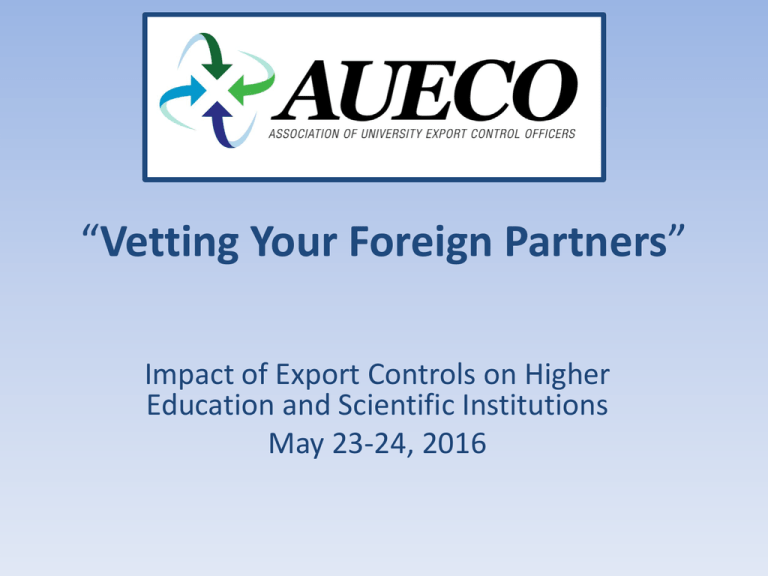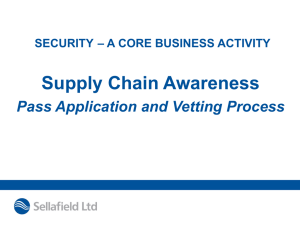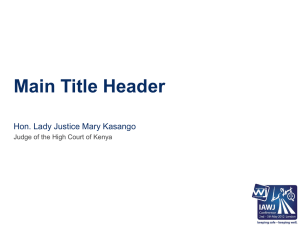Vetting Your Foreign Partners
advertisement

“Vetting Your Foreign Partners” Impact of Export Controls on Higher Education and Scientific Institutions May 23-24, 2016 Don Fischer, JD, LLM Fischer & Associates http://fischer-associates.com/ Vetting Your Foreign Partners Session Objectives: • Identify 8 commonly encountered scenarios and provide recommended guidance • Discuss alternative ways by which to successfully address these scenarios • Identify other challenging scenarios and guidance worth sharing Vetting Your Foreign Partners Scenario 1: Hosting an unrestricted scholar from a restricted institution • Principal Investigator in Engineering Department • Visiting research scholar not on a U.S. Government watch list; but the institution the scholar works for is listed. • Restriction on non-U.S. institution includes EAR99 items • Scholar will access and use 2 labs • Lab 1: basic “lab bench” with no sophisticated scientific instruments • Lab 2: contains equipment and computer screens where dual-use controlled instruments are operated for fundamental research purposes. Should you proceed with the visit? If yes, how? What if the scholar’s home entity is not, per se, restricted but is affiliated with a restricted entity? Vetting Your Foreign Partners Scenario 1 – Guidelines: Confirm that there is no possible access to any item/data/software that is ITAR controlled or proximity to a restricted project. (presumably these have been addressed through a TCP.) Confirm that with respect to Lab #2, the scholar is not obtaining any development, use or production technology when operating any dual-use instrument. (See TCP) Determine whether the research scholar will exclusively be working on a project fully covered by the FRE. If all research to be conducted by the scholar is eligible for FRE coverage, what then? Many institutions take the extra step of documenting a Letter of Assurance to be signed by the scholar: a. Acknowledging that his home (or an affiliated institution) is a restricted entity for U.S. export control purposes; and b. Stating that notwithstanding the objective to conduct fundamental research, s/he may not transfer by any means any information that is outside the scope of the research to the home institution or to an affiliated institution. Examples include photographs or video data of laboratory processes; or information heard or overheard about another project, regardless of the nature of the project. Vetting Your Foreign Partners Scenario 2: NASA in the Air • Similar facts to Scenario 1 – except PI has NASA funding • Visiting scholar working on different (non-NASA funded) project, in a different lab, but in close proximity to the NASA project. • PI can restrict the NASA work to its designated lab, but it could be hard to guarantee an “absolute firewall around the scientific excitement generated in the lab” by the grad students. (i.e., overhearing) • Scholar’s home institution not restricted, per se, but appears to have some affiliation with the People’s Liberation Army. Too close for comfort? Vetting Your Foreign Partners Scenario 2 – Guidelines: While NASA’s restrictions against Chinese research participants does not generally extend to graduate students or post docs, the agency has historically demonstrated broad sensitivity with respect to Chinese exposure to project data, even if the scholar in question is not directly working on the project. Hence, if there is any doubt about the containment of the NASA project (even if it is just grad student buzz), it would be advisable to consult the NASA Program Officer on whether the proposed firewall is satisfactory or whether the scholar’s presence should not be authorized. Vetting Your Foreign Partners Scenario 3: Oye! The New Cuba! • U.S. university wants to host an independent film maker from Cuba to talk about a film that was done documenting the Black Panthers. • Film can be viewed on YouTube.com • Independent film maker does not work for a Cuban institution, but is affiliated with the Cuban Institute for Cinema and Art – which is, in turn, affiliated and supported by the Cuban Government. Does the OFAC General License still apply? Can Support for the Cuban People (SCP) exception apply? Would the film maker qualify as a “Cuban Scholar” under Educational Activities (31 CFR §515.565(a)(5)? Vetting Your Foreign Partners Scenario 3 – Guidelines: 31 CFR 515.582 of the Cuban Assets Control Regulations (CACR) authorizes persons subject to U.S. jurisdiction “to engage in all transactions, including payments, necessary to import goods and services produced by independent Cuban entrepreneurs as determined by the State Department.” However: how does one document that our filmmaker really is an “entrepreneur” and “independent” with no disqualifying ties to the Cuban Government? See State’s webpage: “The State Department’s Section 515.582 List.” (http://www.state.gov/e/eb/tfs/spi/cuba/515582/237471.htm) Vetting Your Foreign Partners Scenario 4: Let’s take a tour! • Physics Department would like to host a 10-member delegation from a Chinese institution. • Chinese institution is not listed on any U.S. Government watch list. • Activity: to tour its lab, sit in on several classes, and participate in several scientific forum of mutual interest (all topics the result of fundamental research). • Purpose: to pave the way for a robust inter-institutional Memorandum of Understanding (MOU) that could lead to numerous student exchanges, faculty collaborations, and participation in an industry-based consortium. • High profile engagement that is being enthusiastically welcomed by the university’s senior leadership. Is it necessary to screen all 10 participants? Wouldn’t the visa vetting process by the State Department be sufficient? Vetting Your Foreign Partners Scenario 4 – Guidelines: 1st Question: Generally speaking, yes it is necessary to screen all participants. Even though the Chinese institution is not listed, and the content of the visit is unrestricted, one would want to know whether an individual member of the delegation is potentially watch-listed. Why? 1. There could be some transfer of EAR99 data – in potential conflict with a broad export restriction applicable to that person; 2. Down the road, is it really prudent to engage more substantively with a restricted individual? Likely not. 2nd Question: While the State Department screens visa candidates, it is still the university’s responsibility to “know” who they are sponsoring or allowing to work on their campus and in their labs. There also remains the possibility of a shift in status post-arrival: the person arrives on a 6 month or 1 year visa, the watch list status subsequently changes, and before the visa is revoked, they are on your doorstep. This is where continuous screening processes are of benefit. Vetting Your Foreign Partners Scenario 5: “Published” software: Do I still need to screen known users? • Principal Investigator generates molecular analysis software (.exe code) • Software is available free of charge through a portal on PI’s science webpage • Through this portal, potential users must register and agree to two conditions 1. To accept and use updated versions of the software/manual as they are released by the PI; and 2. Not to disseminate the software to any other person/institution without first notifying the PI • PI has no intention of commercializing any subsequent version of the software, and has never rejected any request to download. • As far as PI is concerned, the software “is in the public domain.” Does this scenario trigger a screening obligation? Vetting Your Foreign Partners Scenario 5 – Guidelines: 1st Question: the EAR provides definitions and some guidance on what constitutes “publishing” software so as to place it in the public domain. (See Supplement No. 1 to Part 734). As such, we know that software which meets this definition, free for anyone to download and use falls outside the EAR – the same way any other published material would. However, in this case, the PI has reserved the right to decline a potential user, and in all cases, the PI knows who the user is as part of the vetting process. While the EAR has not definitively covered this scenario, our current thinking is that the PI’s registration process effectively keeps the software within the coverage of the EAR: as a result, there is an obligation to screen known potential users against the U.S. Government watch lists. In this case, it is analogous to the requirement of screening potential licensees of commercialized software. Vetting Your Foreign Partners Scenario 5 – Guidelines (continued): What if the software user who freely downloaded the software from a web link (no conditions) contacts the PI and asks for advice on how to use or apply the software? Game changer?: No: it would still be necessary to confirm that the user is not based in an OFAC-sanctioned country for purposes of complying with OFAC licensing requirements pertinent to “services” and that the user is not on a U.S. watch list. But what if the respondent (Iranian and not on any watch list) says they’re conducting fundamental research and that is what the information about the software is being used for: wouldn’t this qualify as a collaborative fundamental research scenario exempt from licensing? It is not clear: the dialogue is not the result of a mutually agreed upon fundamental research exchange, per se, leading to a joint publication effort – but in fact may essentially accomplish the same objective. May be ripe for an Advisory Opinion from OFAC. Vetting Your Foreign Partners Scenario 6: A match to someone else’s watch list? • Screening of a potential research sponsor based in India reveals the entity is not on a U.S. Government watch list, but is listed on a Japan watch list. • Further research indicates the potential sponsor is a leading defense research organization in India with significant affiliation to India’s military aircraft and naval programs. • The proposed research is fundamental research, though arguably one applied outcome could be of interest to a defense organization: a nano-fabricated material that has extraordinary heat and radiation sensing properties. Does this sponsorship present any export compliance issues? Vetting Your Foreign Partners Scenario 6 – Guidelines: While the fact that the Indian entity is listed on one of Japan’s watch lists is interesting, it does not in itself present a prohibition from our U.S. export regulatory perspective. The real concern would be whether during the course of fundamental research your research team would be called upon to provide any information (remotely or in person) to the sponsoring organization that could potentially be defined as a defense service under ITAR Section 120.9. Such information could be in relation to an applied outcome or independent thereof. If upon, analysis, the sponsored work is strictly laboratory generated fundamental research resulting in publication, the fact that there could be an applied outcome with a dual-use scope would not be a reason to decline the opportunity. That said, however, perhaps a proactive conversation with the PI about what constitutes a defense service would be prudent. Vetting Your Foreign Partners Scenario 7: Iran Sanction Relief: Business as usual? • Principal Investigator has developed a useful genotype (EAR99) about which: a. He publishes aspects of the genotypes; and b. Offers full genotype data packages to international collaborators through a signed Material Transfer Agreement (MTA). • Iranian Ph.D. candidate who is working in an analogous field would like to obtain the genotype through an MTA. • Many of the Iranian’s colleagues in European universities already have the genotype and are openly discussing various properties at international conferences. Would the genotypes qualify as “information/informational” materials, now that 31 CFR §560.315 includes “publication” in the definition of information/informational materials; or would the furnishing of the genotypes constitute a “service” thereby triggering a specific license requirement? Vetting Your Foreign Partners Scenario 7 – Guidelines: Furnishing the genotype through a Material Transfer Agreement would be very likely be defined by OFAC as a “service” requiring a specific license. Even though the PI has published frequently about the genotype and information is commonly shared, the genotype package provided through an MTA would likely not constitute “information/informational” materials “fully created and in existence” at the time of transaction. In order for information to be covered under a license exception, under subsection (c)(2), such information has to be created/fully in existence at the time of transaction. Vetting Your Foreign Partners Scenario 8: Participating in a Global Consortium • Principal Investigator has been invited to participate in a London-based global consortium of research institutions that is involved in cutting edge battery cell development. The goal: “to foster research in this field that could (though not necessarily) lead to publication (patent or scientific) and as well as the commercialization of certain commodities down the line.” • In order to participate: • The university must sign on to a publication restriction which makes publication strictly conditional on the vote of the Consortium’s editorial committee; and • The PI must contribute 50 hours/year of agreed upon work to another consortium member in the event that such work would further everyone’s mutual interest. • Of the appropriate 40 consortium members, at least two institutions happen to be located in OFAC-sanctioned countries – Iran and Cuba. Does participating in this Consortium trigger a watch list screening obligation? How about an OFAC issue? Vetting Your Foreign Partners Scenario 8 – Guidelines: Yes and Yes. First – from a screening perspective, it is clear that under the participation terms, the work conducted by the PI is not FRE-covered and could very well be specifically controlled under the EAR. As such, when the PI shares information developed pursuant to the Consortium, one would need to know whether any recipient is on a U.S. Government watch list. What then about OFAC issues? If the requirement is to provide that 50 hours to the Iranian or Cuban member, a specific license would be required. One potential solution might be to proactively determine if the 50 hours need not be directly provided to the Iranian or Cuban entity. However, this might not solve the issue, as those entities will still benefit from the work to one of the other permitted entities. At a minimum, it would be worth filing a request for an Advisory Opinion from OFAC to see if participation of this sort could be exempt from a licensing requirement. Vetting Your Foreign Partners Key Conclusions: • Exercise caution when vetting international parties in the foregoing scenarios: When identifying a problematic scenario, consider immediate communication with stakeholders to determine a reasonable solution, including potential suspension of the transaction. • Inclusion of these scenarios in your annual training modules can be beneficial so that faculty and campus operations are not broad sided. • Ensure that your watch list screening capabilities are sufficiently robust to handle these types of issues. Vetting Your Foreign Partners


